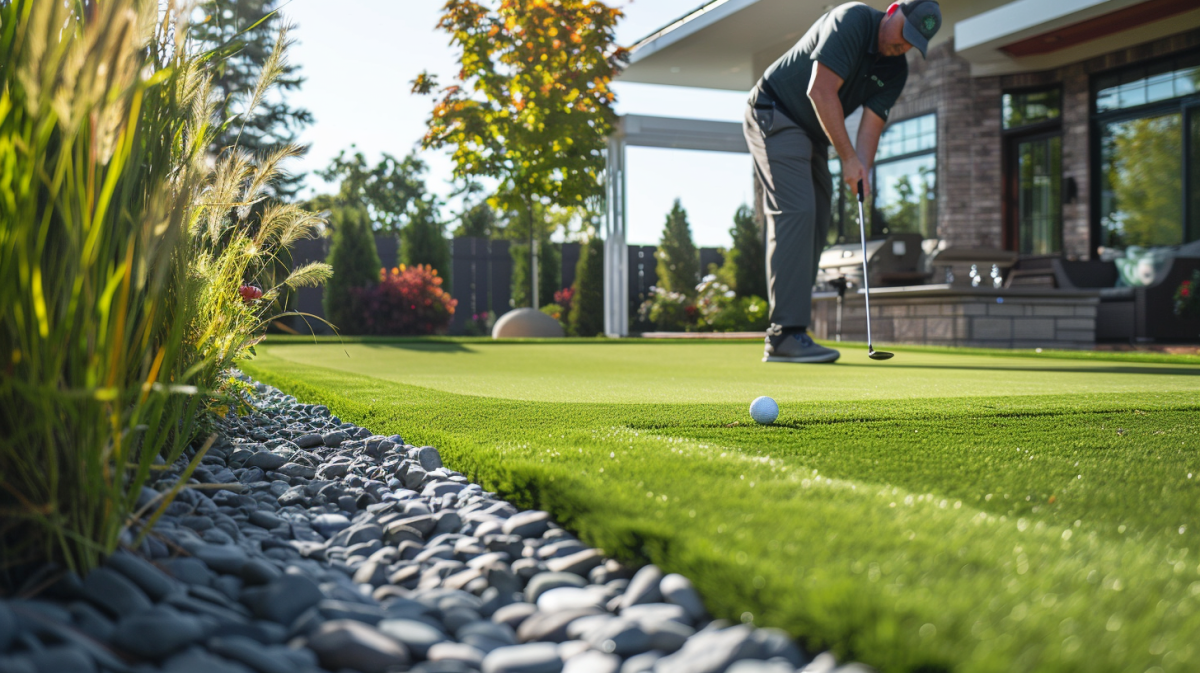Whether you're looking to shave strokes off your handicap or just want a fun project that combines your love of golf with quality family time, transforming your backyard into a golf course has never been more achievable. With options ranging from simple DIY solutions to professional-grade installations, you can create a practice space that fits your budget, skill level, and available space.
The best part? You'll save money on driving range fees while getting unlimited practice time right outside your door. Plus, your kids will think you're the coolest dad on the block when they can invite friends over to play on your personal golf course.
Do You Own Your Home Or Rent?
Before diving into your backyard golf project, these key factors will determine your success and enjoyment for years to come.
- Space Requirements: Most options need 10-15 feet minimum depth, with width varying by setup type
- Budget Planning: Costs range from $300 DIY solutions to $15,000+ professional installations
- Maintenance Commitment: Artificial turf requires minimal upkeep while natural grass needs regular care
- Family Integration: Choose options that accommodate different skill levels and ages
- Weather Considerations: Outdoor setups need drainage planning and equipment protection
- Neighborhood Impact: Consider noise levels and ball containment for nearby properties
- DIY Putting Green Installation - The Gateway to Backyard Golf
- Backyard Driving Range Setup - Unlimited Ball Striking
- Golf Simulator Installation - Year-Round Virtual Golf
- Mini Golf Course Creation - Family Fun Meets Golf Practice
- Complete Practice Area Design - The Ultimate Golf Backyard
- Professional Golf Course Features - Bringing Augusta to Your Backyard
- Transforming Your Yard Into the Ultimate Golf Experience
DIY Putting Green Installation - The Gateway to Backyard Golf
Installing a putting green is often the perfect starting point for your backyard golf transformation. According to Tour Greens, professional putting green costs range from $20 to $ 30 per square foot for larger installations. In contrast, DIY putting green kits featuring interlocking base panels cost approximately $13 to $ 18 per square foot and range in size from 200 to 500 square feet.
The BirdieBall Outdoor Putting Green offers grain-neutral turf with stimp ratings in the 10-11 range, providing authentic ball roll that rivals professional courses. These systems are designed for serious practice - not just casual putting around.
For the DIY approach, companies like American Greens offer Major Series outdoor putting green kits that come complete with artificial grass putting turf, fringe, important accessories and an instruction manual with visuals for easy installation, backed with a 5-year warranty. Installation typically involves:
- Digging out 4 inches of existing sod in your desired shape
- Spreading and compacting 2 inches of rock base
- Adding 1.5 inches of compacted stone dust
- Rolling out the provided turf and securing with stakes
The key advantage of starting with a putting green is that it gives you immediate feedback on your short game while taking up relatively little space. Most backyard installations work well in areas as small as 12x12 feet, though larger spaces allow for more interesting breaks and undulations.
Backyard Driving Range Setup - Unlimited Ball Striking
Creating a driving range in your backyard transforms practice from something you have to drive to into something you can do during a quick work break. A simple net and mat combo can cost under $300, providing an immediate solution for unlimited ball striking practice.
The foundation of any driving range setup is a quality golf net. The Net Return is considered one of the best golf practice nets available, with sturdy construction that withstands impact up to 200 mph, though at almost $600 it represents the premium option. For budget-conscious golfers, the Himal Outdoors 10x7ft Heavy Duty Golf Practice Net provides excellent value, offering a generous hitting area for the full range of shots from driver to wedges with quick setup and a carry bag for easy storage.
Your hitting surface matters just as much as the net. According to Kaizen Golf, the golf mat is the single most important piece of gear in any backyard golf setup, as it's what your club and body will impact with shot after shot. Cheap mats can lead to injuries and poor practice habits, so investing in quality here pays dividends.
Space requirements are manageable for most yards:
- Minimum dimensions: 10 feet wide by 10 feet deep by 8 feet high
- Ideal setup: 12-14 feet wide for aiming at net center
- Safety clearance: Additional 2-3 feet on sides for errant shots
This setup allows you to practice with every club in your bag while maintaining safety for your property and neighbors.
Golf Simulator Installation - Year-Round Virtual Golf
Golf simulators have revolutionized home practice by combining accurate ball tracking with virtual course play. With innovations driving down prices and multiple options now available for every budget, we may be looking back on right now as the golden age of golf simulators.
A carefully planned DIY home golf simulator build typically costs $8,000-10,000, though basic setups can start around $2,000 with portable launch monitors like the MLM2PRO by Rapsodo or Garmin Approach R10. These radar-based systems provide accurate feedback and integrate with popular golf simulation software.
The beauty of modern simulators lies in their flexibility. For example, a hitting net, mat, and Voice Caddie SC4 or Rapsodo launch monitor is all you need for a basic backyard simulator setup, even if you don't have a covered area. For more immersive experiences, you'll want to add a projector and impact screen.
Space planning is crucial for simulator success:
- Ceiling height: 9 feet minimum, 12-15 feet preferred
- Width: 12 feet minimum to accommodate both right and left-handed golfers
- Depth: 16-18 feet ideal for proper monitor placement and safety
- Floor: Level surface required for accurate readings
For dedicated simulator sheds, these dimensions provide the ideal 10-12 feet between the golfer and the screen, while allowing room for multiple players to watch and wait their turn.
Mini Golf Course Creation - Family Fun Meets Golf Practice
Building a backyard mini golf course combines golf skill development with family entertainment, creating something everyone can enjoy regardless of age or ability. You can build a course with any available combination of bricks, wood, aluminum siding, or whatever materials you have available, with total cost depending on your resourcefulness and complexity.
For a more structured approach, you can create modular mini-golf panels using MDF squares, cutting holes for ball capture and adding composite deck balusters around the perimeter to contain the balls. This modular approach allows you to reconfigure the course layout and store panels when not in use.
The magic of mini golf lies in creative obstacles:
- Simple boundaries: Pool noodles, garden hoses, or lumber frames
- Sand traps: Cookie sheets or shallow containers filled with sand
- Ramps and jumps: Plywood sheets at various angles
- Tunnels: PVC pipe sections for ball travel
- Water features: Shallow pans or kiddie pools as hazards
For truly unique character, consider hunting for obstacles at estate sales, garage sales, and online auction sites like eBay or Facebook Marketplace. Garden statues, vintage lawn ornaments, interesting pottery, or even old kitchen items can become signature features that give your course personality. A ceramic garden gnome creates a perfect "navigate around the obstacle" challenge, while an old colander can serve as an elevated tunnel. These finds often cost less than purpose-built mini golf obstacles and create conversation pieces that make your course a memorable experience.
Backyard mini golf works best with croquet sets rather than traditional golf equipment, as the larger balls are easier to control and more forgiving on uneven surfaces. This makes it perfect for family play while still developing putting fundamentals.
Complete Practice Area Design - The Ultimate Golf Backyard
For the serious golfer with adequate space and budget, combining multiple elements creates the ultimate backyard golf experience. This might include a putting green with multiple pin positions, a driving range with target practice, and even sand bunkers for complete short game practice.
Tour Greens installations often include multiple cuts of fringe and fairway turf, allowing golfers to practice all types of shots. Many customers start with putting greens but quickly inquire about bunkers, tee boxes, and other course features. This comprehensive approach allows you to replicate nearly every shot you'll face on the course.
The key to successful complete practice areas is thoughtful layout design. Start with your largest element - typically the driving range or putting green - then build complementary features around it. Consider sight lines, ball collection efficiency, and how different practice areas can flow together for varied practice sessions.
Drainage becomes especially important with larger installations. Poor drainage can ruin expensive artificial turf and create muddy conditions that make practice unpleasant. Professional installations always include comprehensive drainage systems, which DIY builders should seriously consider for larger projects.
Professional Golf Course Features - Bringing Augusta to Your Backyard
For golfers seeking the ultimate backyard golf experience, professional-grade features can recreate the challenges and aesthetics of championship courses. This includes properly constructed sand bunkers, water features, and even replica holes from famous courses.
Sand bunker construction requires proper drainage, specific sand types, and strategic placement to create realistic practice conditions. Many Tour Greens customers opt to add bunkers around their putting greens to simulate real course conditions and challenge their short game skills.
Professional bunker installation involves:
- Excavation: Proper depth and contouring for realistic ball lies
- Drainage systems: Preventing water accumulation that ruins sand consistency
- Sand selection: Specific grain size and composition for authentic play
- Edging: Clean lines that mimic championship course aesthetics
Water features add both beauty and challenge to backyard golf courses. These can range from simple retention ponds that double as hazards to flowing water elements that incorporate pumps and filtration systems. While complex, water features create the psychological pressure that makes practice more game-like.
Professional installation ensures proper construction techniques, appropriate materials, and compliance with local regulations. Professional installation removes any guesswork and ensures many years of backyard enjoyment, with labor accounting for 70% to 95% of total installation costs due to the knowledge and precision required.
Transforming Your Yard Into the Ultimate Golf Experience
Transforming your backyard into a golf course isn't just about improving your game - it's about creating a space where passion meets practicality. Whether you start with a simple putting green or go all-out with a complete practice facility, you're investing in convenience, family time, and golf improvement that pays dividends every time you step onto a real course.
The most successful backyard golf projects start small and grow over time, allowing you to learn what works for your space, budget, and playing style. Begin with one element that excites you most, master it, then expand as your vision and budget allow. Remember, even professional golfers started with basic practice setups - the key is consistent practice, and there's no more consistent practice than having a course in your own backyard.
Hey James Hills wants you to share this!

